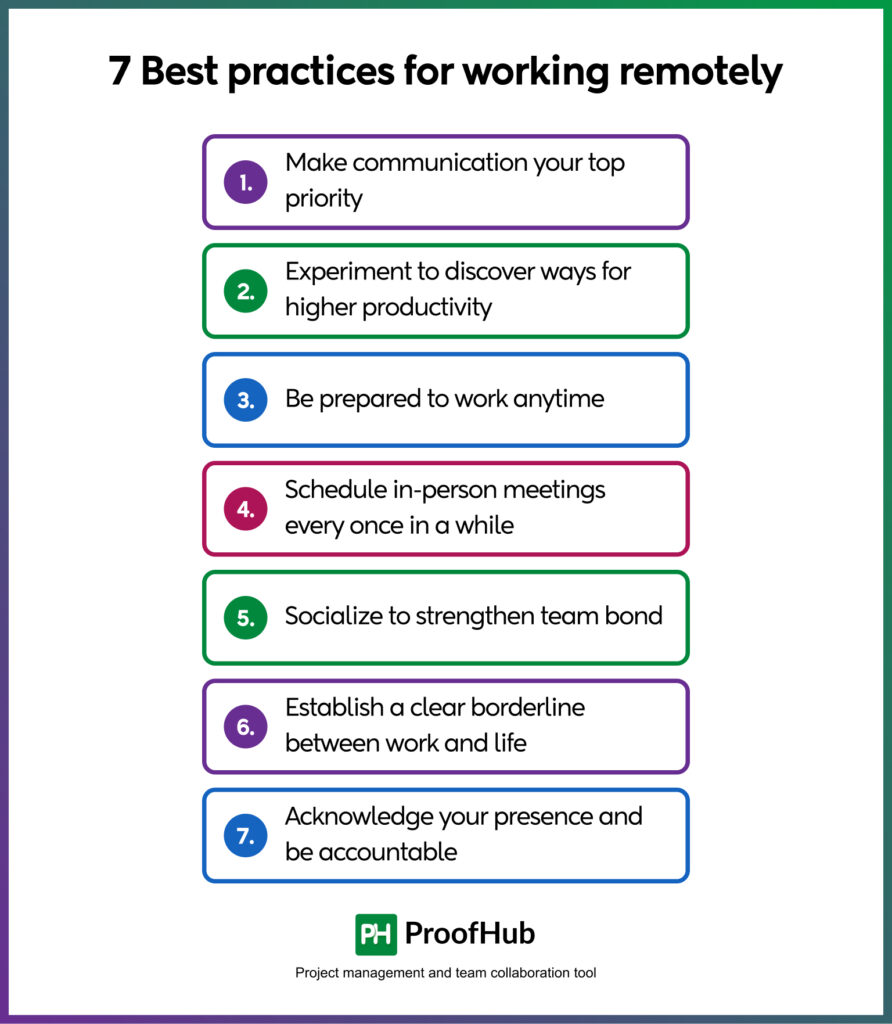Remote working today is well-defined, and it has become a norm for many organizations to manage remote teams and for individuals to work as a full-time remote employee.
However, the scenario was much different when remote working was a new concept for most people.
Individuals who started working remotely when telecommuting has just emerged as a possibility faced a lot of challenges such as low productivity, lesser engagement, loneliness, and isolation.
Even people who are making a transition to remote work nowadays often complain that they find it difficult to fit into this new work style.
In such a situation, the most viable way to figure out things that work for an individual as a remote worker is to go with the trial and error method.
However, apart from being a time-consuming process, you have to put extra effort to try several ideas and identify the ones that can actually help you become a productive remote worker.
Eventually, you may end up worn out yourself and conclude that remote work is not your cup of tea.
Well, over the years, many people successfully overcome the challenges of working remotely. And from time to time, they have shared their secrets for staying happy and productive at a remote workplace.
In this article, we are going to reveal the best practices for working remotely that are suggested by seasoned remote workers.
By making these practices a part of your daily regime, you can be at your best and become a prolific remote employee. So, sit back, relax, and simply follow these practices to improve your remote working skills and become a valuable asset to your organization.
Remote work popularity & acceptance: A data review
Remote working has evolved from being just another way to make ends meet into a mainstream career. The flexibility of working from anywhere is what makes remote work so popular among the people.
According to a study conducted by FlexJobs and Global Workplace Analytics, there was a staggering 159% increase in the growth of remote work in the US between 2005 and 2017.
Moreover, according to Buffer’s annual report on remote work, 95% of the 2500 remote workers said that they want to encourage others to work remotely. The same study also suggested that the biggest reason for people to work remotely is the flexible schedule followed by other reasons, including the ability to work from any location, and spending time with family.
Along with being a favorable work style for many professionals, remote work is also getting attention from more and more organizations. Here are some reasons why businesses are willing to work with remote teams:
- Wider access to talented individuals (no geographical boundaries)
- Reduced business costs (office rent, electricity bills, etc.)
- Less absenteeism (lack of urge to take a random day off from the work)
- Higher employee retention (flexible work options tends to boost the loyalty of employees)
In my opinion, these facts would be enough for you to keep yourself motivated as a remote employee.
Now, it’s time to jump and check out the list of best practices that are going to be your saviour while you work remotely for any organization.
7 Best practices for working remotely
1. Make communication your top priority
Working from home or a remote location doesn’t mean that you have to go solo. It’s highly unlikely for a team, especially a remote one, to achieve success if some or all the members play by their own rules.
While it’s true that communicating with your remote co-workers can never be the same as that in a traditional office environment. However, it doesn’t mean that you cannot make your virtual communication highly effective.
All you need to collaborate effectively with your fellow team members is to make use of the leading communication tools such as chat apps, video conferencing tools, and project management software.
The success of a remote team is highly dependent on the degree to which they can communicate productively.
Also, by staying connected with your team, you can avoid getting stuck in a task because you can easily get all the help from your co-workers to overcome a difficult situation with relative ease.
2. Experiment to discover ways for higher productivity
Stop assuming that when you work from a place of your choice, you will be at your optimum productivity level throughout the work hours.
In fact, while working remotely, you are most likely to skip short breaks that are extremely important to stay productive.
At the office, taking a break to get your favorite snack, drink coffee, or having a watercooler chat seems so natural. However, when working away from the office, short breaks may feel like cheating with your work.
However, you may be surprised to know that short breaks are among the proven tips to stay focused while working remotely.
So, what you need to do is to follow the best remote working tips and try multiple productivity tools to make your remote life easy. If you feel that a certain activity like doing a stretching exercise during breaks makes you more productive, then you should make it a part of your daily work routine.
Additionally, you should also experiment with other things like the height of your chair, the ambiance around your workspace, clothing, etc, to identify the instances when you are more productive and less distracted.
3. Be prepared to work anytime
Working in a remote team means that there may be team members who are working across different time zones.
As a remote worker, you can’t be rigid with your working hours as someone working in another time zone might need to coordinate with you on a project task.
Thus, you have to work out a solution to deal with such situations and should prepare yourself mentally to connect with a team member during non-work hours.
If a portion of your work hours coincides with the work hours of your fellow mate, then you need to make sure that you capitalize and schedule all your discussions within that time window.
It is also possible to choose a specific time of the day, which is suitable for both you and the other team member to carry out a meeting.
But make sure that you define boundaries when it comes to availability. Obviously, no one will like to get disturbed in the middle of the night by a colleague just to tell the progress of their current task.
4. Schedule in-person meetings every once in a while
Face-to-face meetings are not only effective from the communication point of view but it also allows remote workers to develop a sense of trust among themselves.
You must encourage in-person meetings with your colleagues from time to time to develop a personal connection with them.
Usually, it’s the responsibility of a team leader or project manager to arrange face-to-face meetings among remote team employees. However, you can also take charge and schedule a face-to-face meeting with one or more members of your remote team.
Apparently, for big remote teams and teams whose members are separated by large geographical distances, limiting such meetings to once or twice a year is the best option. However, connecting over a video conference is the next best thing to a face-to-face session that remote teams should practice.
5. Socialize to strengthen team bond
Socializing is imperative to reinforce your bond with your remote colleagues. You should spare some time to interact and socialize with people with whom you are working as a team.
At some point, after you start working from home, you may start feeling lonely, and the isolation that seems to be the best part of remote work tends to slide a sense of unease in you.
To keep yourself motivated and feel connected with your team, you need to dedicate efforts to understand your teammates.
It’s a good idea to create a separate chat group with your teammates where you can discuss things that are related to work. Also, you can have social video sessions, where you all talk on random topics and even show others your pet who is your roommate.
Another popular way to bring remote teams together is to conduct various remote team building activities and games. These activities and games create a funnel for team members to know about the personalities, likes, and dislikes of each other.
6. Establish a clear borderline between work and life
Usually, while working from home, the difference between work and personal life becomes fuzzy.
As a result, you may fail to recognize the difference between your professional and personal life.
It will become a habit to work and check work emails outside the work hours. So, what you need to do is to draw a clear line between work and non-work hours.
You need to unplug yourself completely once you are done with your defined work hours. Working for extra hours regularly will result in burnout and also compromise with your health.
Therefore, you need to switch off all the devices that you use for work. In case you are a single device for both personal and professional use, you can turn off or mute notification related to work.

7. Acknowledge your presence and be accountable
Unlike a traditional office, nobody is watching you and they have no hint of what you are working on.
So, what you need to acknowledge your presence among your colleagues and manager is to inform them about the tasks that you are currently doing.
Even if your manager forgets to ask you about your current assignment, you need to voluntarily tell them the status of your work. Also, ask for feedback from your manager or immediate supervisor to let them know that you are an active member of the team.
Another useful tip to become visible to your remote team is to reply quickly to the messages and comments. Also, if you are using project management software like ProofHub, you can initiate and participate in discussions, create notes and share them with colleagues, mark the progress percentage of a task from time to time, and chat with team members in real-time to enhance your visibility.
Conclusion
The trend of remote working is rising exponentially all thanks to the flexibility that individuals get when they work from a space of their choice. Moreover, many experts even believe that remote work is the future of the modern world and we all need to embrace it sincerely. While you start working as a remote worker, it will be good if you follow the best practices for working remotely mentioned in this article as these practices will help you to settle into your new workplace easily.

